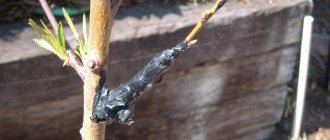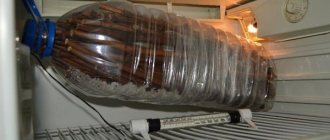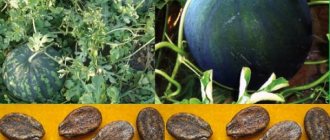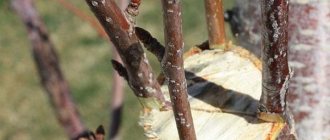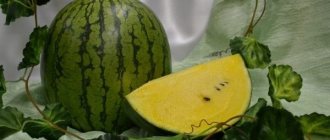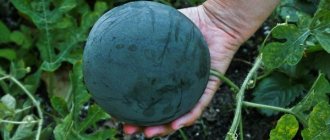Is it possible to graft a watermelon onto a pumpkin?
Grafting a watermelon onto a pumpkin is not only possible, but also necessary. The melon culture has the necessary properties and is able to strengthen the watermelon and improve the quality of its fruit.
First, you need to study the technology of grafting, as well as select the right plant varieties. So, a suitable type of watermelon is Astrakhan, Kherson, Kholodok or Chernouska.
Additionally! Zucchini is one of the plant's options as a rootstock, but not very popular.
Methods and technology for grafting cucumbers
There are several grafting methods that can be carried out on cucumber plants.
Into the cleft
Cleft grafting is most common when using a tladiantha or lagenaria stem as a rootstock.
How to graft a cucumber:
- To grow a rootstock, sow sprouted tladiantha or lagenaria seeds in a pot or box 2-3 days before sowing the cucumber seeds. This will provide the necessary “race” in the development of the scion.
- After 2 weeks, cut off the top of the future rootstock, leaving a part of the plant 4-6 cm high (from the soil to the cotyledon leaves).
- Then cut the rootstock lengthwise with a razor to a depth of 1.5-2 cm. At this time, the future scion will form two cotyledon leaves.
- Cut the scion below the cotyledon leaves by 3-4 cm.
- From opposite sides of the cut cuttings, use a blade to remove a thin layer of epidermis 1.5-2 cm long.
- Insert the cutting into the split of the rootstock so that the layers of the rootstock and scion coincide.
- Then tightly tie a narrow strip of plastic wrap around the area.
- Remove it when the rootstock and scion grow together.
Side cut
Grafting into a side cut of the stem is successful on hollow rootstocks.
How to properly graft a cucumber onto a pumpkin or lagenaria:
- At any point on the stem, make a longitudinal straight cut through the entire depth of the fabric to the hollow space. The length of the longitudinal incision should not be more than 1.5-2 cm.
- Cut the scion in the cotyledon phase immediately from the root.
In some cases, grafted cucumber plants not only feed on the root system of the rootstock, but also form additional roots themselves, growing through hollow spaces.
Injection
Gardeners use this method of grafting quite often:
- Take a nail, sharpened on both sides in the form of a screwdriver. The diameter of the nail should be equal to the width of the scion stem.
- In the axil of the rootstock leaf and at the top of the stem, use a sharpened nail to make a puncture to a depth of 0.8-1 cm and insert the scion there. First remove the epidermis from both sides. The scion is in close contact with the rootstock, so tying is not necessary here.
Injection grafting can be simplified: a cut scion (cucumber), from which the epidermis has been previously removed by 1.5 cm, is inserted immediately into the hollow space of the pumpkin stem. To do this, you need to cut off the growth point of the pumpkin “to a stump”, leaving 2-3 true leaves on the plant and a stump 1.5 cm high above the last leaf. The scion and rootstock will grow together along the entire circumference of the adjacent stems.
By rapprochement
Convergence grafting is also more suitable for “hollow” rootstocks. Sow the seeds for the scion with the future rootstock in the same pot. This grafting is best done for plants that have difficulty merging with each other (for example, melon and tladianta, cucumber and zucchini). They can be connected to each other without separating the roots.
In places where both plants touch, remove the skin along the stem by 1.5-2 cm and tie it with cut strips of film.
After merging, trim the rootstock plant to the root.
Insert
First, graft the rootstock into the scion. When it grows, graft another rootstock onto it, leaving 2-3 leaves on the previous one. This intermediate scion will be under the double “influence” of roots and leaves.
With this grafting it is possible to ensure that one plant simultaneously provides a high yield of cucumbers, is early ripening and resistant to low temperatures. So, a large-fruited pumpkin and then a cucumber can be grafted onto the fecifolia root system.
Will pumpkin affect the quality of watermelon fruit?
The positive effects of combining watermelon and pumpkin were outlined above. Pumpkin is endowed with strong roots that are resistant to frost. Thanks to this, the watermelon will be able to absorb liquid faster and receive nutrients from the ground in larger quantities. Such a root system will protect the plant from diseases.
Proper development will contribute to the active ripening of large fruits with rich sweetness and juiciness. The berry will retain its individual taste qualities in accordance with its genetics; in this regard, the pumpkin will not affect them.
The timing of vaccination is individual and depends on the climatic conditions of growing watermelon
Growing seedlings for grafting
Seeds of both crops need to be planted for seedlings 7–10 days earlier than usual, so that the seedlings have time to grow together reliably before transplanting into the garden bed. By this time, it is desirable for the “hybrids” to have 5–6 true leaves and at least one tendril.
The rootstock, as a rule, grows more actively than the cucumbers themselves, which it is advisable to give a “head start” in another 4–5 days. To ensure that its root system develops from the very beginning, provide the pumpkin or zucchini with enough space by planting it in a container with a volume of about 0.5 liters. But in this regard, you can save on cucumbers.
Seedlings of pumpkins and zucchini develop more actively, so cucumbers need to be planted a few days earlier so that the plants have approximately the same dimensions
It is advisable to grow seedlings in sawdust, perlite, vermiculite, coconut fiber, and sphagnum moss. Particles of ordinary soil are more difficult to clean from plants, and if they get into the cuts made, the operation will definitely not be successful.
Grow the scion and rootstock in a substrate that can be easily removed from the roots and stems of the seedlings
Seedlings must have strong, thick stems. You can't let her stretch out. This is caused by:
- lack of additional lighting during early sowing periods;
- elevated temperatures (more than 23–25°C);
- too much watering;
- excessive crowding in a container with seedlings.
Elongated cucumber seedlings with thin stems are not used as scion
Video: growing scion and rootstock from seeds
How to graft a watermelon onto a pumpkin
How to graft a watermelon onto a pumpkin - steps:
- Preparation of materials and tools.
- The crossing procedure itself.
- Necessary care and care for the plant.
Tongue
Tongue copulation is the most effective way to cross watermelon with pumpkin, as it provides the plants with a high probability of taking root. Implementation of grafting:
- Plant seedlings 2-3 days earlier than usual.
- Sprout the berries in one or more separate bowls. Make a cut on the sprouted stem of the watermelon, as well as on the pumpkin, about 1 cm deep.
- Fix the formed tongues together. Tie up the crops, make a support in the form of a stick.
- After they grow together, remove the bottom of the watermelon so that it can feed from the pumpkin root.
- The leaves of the grafted plant are removed as they grow.
By rapprochement
The grafting method is similar to the previous one, but differs in that for plant connections, not a cut is made, but only a small cut on the skin. Then the stems touch and tie in the same way.
There are different ways to graft a watermelon.
Copulation
Copulation involves crossing a watermelon and a pumpkin in this way:
- Organize a large rootstock, that is, plant two crops at the same time for their active cultivation.
- Remove the growing point from the pumpkin.
- On the remaining cotyledon leaf of the pumpkin, make a cut parallel to the stem (length up to 8 mm).
- Cut the watermelon stem in the middle, bringing it closer to the rootstock.
- Wrap the splice area with a tight bandage.
Lateral incision grafting
Prepare watermelon and pumpkin seedlings and plant crops. Next proceed like this:
- Remove the root from the sprouted scion.
- For grafting, cut the pumpkin stem diagonally to the middle, and the watermelon stem - right through.
- Combine the berry seedling with the pumpkin and secure.
Lateral incision grafting method
You can quite easily graft a watermelon into a side cut on the pumpkin stem yourself. When the lagenaria sprout already has at least 1 true leaf, and the kavuna seedling has 1–2 leaves, the plants can be grafted. Using a sharp knife blade, make a vertical cut approximately 1.4 - 2.0 cm long on the pumpkin stem below the cotyledon leaves. Using the same sharp blade, cut off the watermelon top at an acute angle below the cotyledon leaves.
The cut top of the watermelon is inserted into a vertical cut on the watermelon stem, so that the cut surfaces of the two plants are in close contact. The grafting site is secured with a grafting clip for several days.
Important! Do not remove the grafting clip before the prescribed time. This can lead to disruption of the fusion of the scion and rootstock.
A greenhouse effect is created for the plant by cutting off one side of a plastic bottle or plastic bag for the period of overgrowing of the cuts. Approximately 10 days after a successfully completed grafting, the top of the lagenaria is cut off, leaving an established watermelon sprout. This results in a new plant with watermelon tops and a powerful pumpkin root system, capable of actively taking moisture and all the necessary nutrients from the soil even at low ambient temperatures. The roots of an ordinary watermelon, which is accustomed to growing in well-warmed, light soils, do not have such features.
Features of the procedure and useful tips
It can be difficult for new gardeners to cross plants successfully. To conduct the event correctly, it is useful to familiarize yourself with the available video lessons, as well as follow the basic recommendations:
- Pay attention to preparation: check tools for functionality, treat materials and hands with an alcohol solution.
- Choose the time for the operation, it is better to give preference to the evening or cloudy morning. Throughout the growth of plants, they should not be exposed to sunlight.
- Ensure optimal room temperature - from 25 degrees, humidity - above 70%.
- Since the pumpkin has a wide root system, you need to choose a container of the appropriate size for it.
- Before grafting, water the pumpkin generously.
To obtain a high yield, the grafted plant requires proper care.
Butt grafting method
Watermelon seeds - how to prepare for sowing
When the pumpkin seedling has 1 true leaf, and the watermelon sprout has 1 - 2 leaves, you can graft using the end-to-end method. Using a blade, a very sharp knife or a surgical scalpel, an oblique cut of the stem is made on the lagenaria. In this case, the growing point and one cotyledon leaf are removed, the second should remain intact on the stem.
Butt-butt
The top of the watermelon sprout is cut obliquely below the cotyledon leaves and connected to the pumpkin cut. Both stems are connected using a special clothespin or clip. The grafted plant needs to be provided with warm and humid environmental conditions for faster and easier engraftment of cut surfaces. For this purpose, the pot with the plant can be covered with a plastic bottle or plastic bag cut off on one side. The ambient temperature should be between +24°C and +26°C. It will take several days for the sprouts to engraft, after which the connecting clip is removed.
Caring for a grafted plant
The care plan for a grafted watermelon is as follows:
- ensuring optimal soil moisture in containers with seedlings;
- periodic gentle watering;
- in controlling the growth of the crop: gradually the watermelon gets stronger and grows, leaves appear. With their appearance, the 2nd and 3rd leaves are pinched, and the sprout of the grafted pumpkin can be cut. If the berry develops favorably, the clip must be removed;
- systematic planting in open ground. Fertilizer is first added to the soil, then the crop is watered no more than once a week.
The article provides up-to-date information on the question: is it possible to graft a watermelon onto an ordinary pumpkin? A gardener can choose the most optimal method of crossing for himself, while observing the basic rules and advice of experts.
Grafting methods
Breeders have 4 methods of grafting watermelon onto pumpkin. The most popular and simplest is the reed method. It is suitable for those who have no experience in crossing plants. Experienced gardeners choose other grafting methods. The seeds of melon crops planned for crossing are planted in the same or different containers.
On a note! Pumpkin sprouts much earlier than watermelon. In order for the seedlings to be the same age, you need to start germinating it 4-5 days later than the red-green berry.
Tongue
The reed grafting method ensures high survival rate of seedlings. They begin to cultivate those seedlings that have already formed 2, or preferably 3, leaves. Older specimens of watermelon and pumpkin are not used for grafting; only the period when the plant has the specified number of cotyledons is optimal.
The crossing technique involves making one cut on the stems of plants of both species. Its parameters:
- distance from leaves 5-7 cm;
- length – 5 mm;
- depth – 75% of the stem.
The notch must be oblique (for a pumpkin - from top to bottom, for a watermelon - from bottom to top). The sections are connected using a locking method and secured with foil or a grafting clip.
The resulting seedling mix is planted in a wide container (0.6-0.8 l) and exposed to light. To start feeding from pumpkin roots, after 5 days a pinch is made on the watermelon stem below the grafting level. And after another 5 days, the excess parts of the seedlings are cut off (watermelon root area and pumpkin top). The healed cut site is freed from the foil.
To the center
In another way, this method of grafting a watermelon onto a pumpkin is called splitting or Chinese technology. It will require a young sprout of local melon with a real leaf that has barely hatched. The main rootstock is the same as in the previous case (with 2-3 leaves).
Grafting a watermelon begins with removing the growth point on the pumpkin using an injection method. Then cut off the leaf with a sharp blade, extending the cut along the stem to a distance of 15 mm. Cut off the top of a watermelon seedling along with the beginnings of the next pair of leaves. A pumpkin blank is inserted into the resulting wedge and the split is fixed.
The result of grafting is planted in an 8-liter container and must be covered with a plastic bottle (so that the graft does not dry out). The fasteners are removed only after the cut sites have healed.
By rapprochement
The scheme of how to graft a watermelon onto a pumpkin by approaching is similar to the tongue method, with the only difference being that maximum contact is artificially created for the plants. It is provided through:
- single-level planting in one container (seedlings are placed side by side);
- on the stems, the skin is cut off from the inside (the point is located approximately 6 mm above the cotyledon leaves);
- in the prepared part the plants are clipped.
Towards the end of the week, the watermelon stem becomes pinched at the bottom. This will block nutrition at the expense of its roots. When the chipped area dries, it is removed. The pumpkin top is cut off at the time of planting in open ground.
Side cut
The technique of grafting watermelon onto pumpkin involves introducing cells from the base plant into the scion. Crossing is carried out in the following sequence:
- An indent of 2 cm is made on the pumpkin stem below the cotyledon leaves. At the marked point, the plant is cut.
- The root of the base crop is cut off. The cut should have an acute angle, the remainder of the stem should be 15 mm.
- The watermelon blank is placed in the side of the pumpkin cut, pressed tightly and tied or secured with a clip.
To provide the plants with suitable conditions for crossing, you can additionally cover them with plastic (a bag or a cut bottle).
Why and what to vaccinate for?
To the question “why?” We have already partially answered. Now let's look at it in more detail. Watermelon grafting makes it possible to:
give the plant the ability to fully grow at lower temperatures and their unfavorable fluctuations;
- get an earlier harvest;
- increase productivity by 2 times by increasing the size and number of fully ripening fruits;
- accelerate the intensity of development of watermelon bushes;
- make plants more drought-resistant;
- increase plant resistance to diseases (especially fusarium).
This effect is achieved by grafting onto lagenaria (bottle gourd), which has a magical effect on the watermelon, improving and enhancing its qualities. Its root system feels great even at a temperature of +5 degrees, which cannot be said about watermelon. Without grafting, it is able to grow normally only in cases where the soil temperature does not drop below +15. As you can see, the difference is colossal. It is this property of pumpkin that allows grafted seedlings to be planted earlier and, accordingly, to obtain a much earlier and more abundant harvest.
Due to the cold resistance of the pumpkin rootstock, most of the fruits set on the grafted plant fully ripen. They grow noticeably larger in size - this is facilitated by the powerful root system of the pumpkin. At the same time, temperature changes no longer have a detrimental effect on the watermelon - it not only survives, but also continues to develop normally. The power of pumpkin also saves it from potential diseases even in the most favorable conditions for them (high humidity).
Types of vaccinations
There are three ways to graft a cucumber onto a pumpkin:
- Into the cleft, into the subcotyledon;
- splicing;
- convergence into the tongue.
Vaccination of watermelon against lagenaria
It is believed that the best results are obtained by grafting into the cleft. Splicing takes longer and is less durable.
Important : a day before grafting, it is advisable to water the cucumber and pumpkin seedlings so that the stems, saturated with moisture, are elastic. The actual vaccination time should not exceed 7-10 seconds. During this time, the bare parts of the plants do not have time to dry out, in this case the maximum effect is achieved.
Grafting into cleft
Briefly: to graft into a split, you need to cut off the stem of the scion (pumpkin) just above the two leaves and make a cut (split) of the stem in the center between the leaves. Insert the upper part of the cut and prepared scion seedling (cucumber) into the resulting cut and bandage the grafting site.
Details. It is necessary to prepare and disinfect the instrument. Usually they use a new razor blade, treating it with alcohol or thoroughly calcining it over a fire.
- Remove the growing point from the rootstock, above the cotyledon leaves. After this, make a cut approximately 1.5-2 cm down from the cotyledon leaves. It is important that the cut is straight and does not go into the hollow interior.
- Cut off the lower root part of the cucumber and leave the upper part with the cotyledon leaves. Peel the stem from the top skin to a length equal to the cut on the pumpkin.
- Open the slit on the pumpkin and insert the cucumber graft. The cotyledon leaves of both plants should be parallel to each other.
- Bandage the vaccination site with a bandage, foil or tape. It is necessary to bandage tightly, but without force, and do not leave open surfaces.
- Cover the plant with a bag or plastic bottle, which will preserve maximum humidity and speed up the fusion of the rootstock and scion.
If successful, after some time the plant will begin to grow. After which, depending on the growing conditions, the seedling needs to be transplanted into open ground.
Grafting by splicing
Short. Grow two seedlings side by side: a rootstock and a scion. On seedlings, at the same level, cut off part of the stem. Carefully connect the stems with cut parts, wrap them and wait for the shoots to grow together. Then remove the root of the scion (cucumber) and pinch the stem of the rootstock (pumpkin). Replant in open ground.
Details. Pre-check the germination of seeds. Sow a pumpkin seed in a peat pot and, after 3-4 days, a cucumber seed next to it. Leave in a warm place. After sprouting, move the pot under the lamp. After the scion and rootstock have fully opened the cotyledon leaves and the first real leaves appear, you can begin grafting.
Important! The day before the operation, you need to water the seedlings abundantly.
- Using a disinfected sharp blade, remove peel strips 3 cm long and up to 1 mm deep from pumpkin and cucumber shoots.
- Connect the places tightly and tie with tape, foil or bandage. After the seedlings have grown together, remove the root system of the cucumber and pinch out the pumpkin. Thus, we get a cucumber trunk and a powerful pumpkin root system. If necessary, you can leave the root system of the cucumber, only by trimming the pumpkin.
- Depending on the growing conditions, transplant the “cucumber on a pumpkin leg” into open ground or a greenhouse.
For what purposes is vaccination used?
A heat-loving watermelon requires that the soil temperature not drop below 15°C during the summer. The branched stem of a watermelon grown from seedlings naturally (on its root) constantly needs warm soil.
What is the advantage of the procedure? Grafting onto pumpkin significantly increases the cold resistance of the crop.
The well-developed root system of bottle gourd is capable of delivering nutrients even at a soil temperature of 7 - 10°C.
This allows the grafted berry to form strong vines with a large number of successfully ripening ovaries.
Grafted watermelons have larger fruits . This is due to the fact that the usual fruit stops growing in the absence of sunny weather for 7 - 10 days (which happens quite often in our summer).
In cloudy weather, a traditional watermelon will immediately begin to ripen, while a grafted one will continue to grow fruit.
In addition, the roots of bottle gourd, unlike watermelon ones, are practically not susceptible to fusarium , a disease that often kills plants.
Grafted watermelons have larger fruits and increased cold resistance
